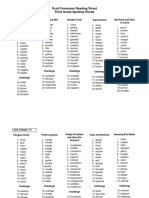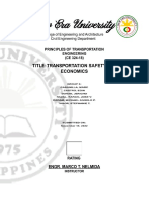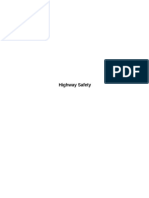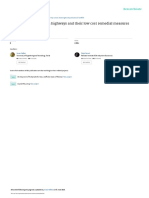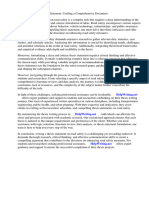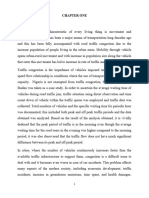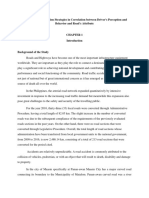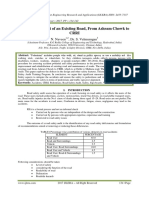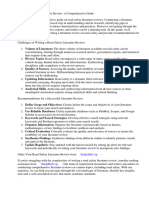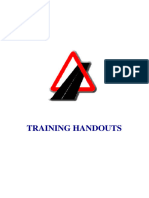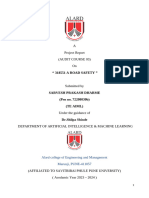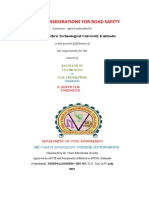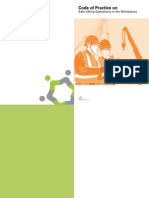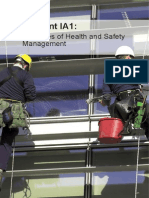Road Accidents and Prevention: April 2017
Road Accidents and Prevention: April 2017
Uploaded by
SERGIOCopyright:
Available Formats
Road Accidents and Prevention: April 2017
Road Accidents and Prevention: April 2017
Uploaded by
SERGIOOriginal Title
Copyright
Available Formats
Share this document
Did you find this document useful?
Is this content inappropriate?
Copyright:
Available Formats
Road Accidents and Prevention: April 2017
Road Accidents and Prevention: April 2017
Uploaded by
SERGIOCopyright:
Available Formats
See discussions, stats, and author profiles for this publication at: https://www.researchgate.
net/publication/315829097
Road Accidents and Prevention
Article · April 2017
CITATIONS READS
0 16,171
1 author:
Faheem Ahmed Malik
Northumbria University
6 PUBLICATIONS 11 CITATIONS
SEE PROFILE
Some of the authors of this publication are also working on these related projects:
Road Traffic Crash analysis and Remedial measures on a National Highway (Motorway). View project
Development of Sustainable Urban Transport for Central Business District View project
All content following this page was uploaded by Faheem Ahmed Malik on 08 April 2017.
The user has requested enhancement of the downloaded file.
© 2017 IJEDR | Volume 5, Issue 2 | ISSN: 2321-9939
Road Accidents and Prevention
1
Faheem Ahmed Malik,
2
Shah Faisal Saleh Faisal Farooq Rather Malik Jasif Jabbar,
3
Inam ul haq Wani Shahid Mushtaq Shah Farooz Rashid
Department of Civil Engineering,
Islamic University of Science & Technology, Awantipora, J&K, India.
________________________________________________________________________________________________________
Abstract—Road accidents cannot be stopped despite providing the best possible roads and intersections, however there are
ways to reduce the impact of road accidents on road-users and the vehicles plying on the road.The incidence of accidental
deaths has shown an increasing trend during the period 2005 - 2015 with an increase of 54.3% in the year 2015 as compared
to 2005 increase in the rate of accidental deaths during the same period was 25.5%.A total of 4,00,517 accidental deaths
were reported in the country during 2015 (5,535 more than such deaths reported in 2014) showing an increase of 1.4% as
compared to 2014. However, the average rate of Accidental Deaths has remained same 32.6 in 2014 and 2015.In the stretches
we studied the road accidents are increasing rapidly .We studied accidental records of various police-stations ,identified the
black-spots of accidents and then analyzed the geometric features of those spots whose observation is given in this paper .The
identification of such points provides us ease to work on some section of road which is most prone to accidents .We analyzed
the geometric deficiencies and they recommended ways to reduce their affects. The findings indicated that large radii right-
turn curves were more dangerous than left curves, in particular, during lane changing maneuvers. However sharper curves
are more dangerous in both left and right curves. Moreover, motorway carriageways with no or limited shoulders have the
highest CR when compared to other carriageway width. Proper traffic guidance and control system to guide road users
ensuring safe movement of vehicles has been recommended and some of the facilities such as pedestrian crossings and
median openings, acceleration and deceleration lanes were re-designed in order to improve the safety of the road and
minimize the accidents.
Index Terms—Component, formatting, style, styling, insert.
________________________________________________________________________________________________________
I. INTRODUCTION
The problem of accident is a very acute in highway transportation due to complex flow pattern of vehicular traffic, presence of
mixed traffic along with pedestrians. Accidents are multifactor and random. Traffic accident leads to loss of life and property. Thus
it is imperative that traffic engineers take the big responsibility of providing safe traffic movements to the road users and ensure their
safety. The aim of zero causality is although difficult even considered impossible by some, but with the latest technologies and
advancement in the field it is possible to reduce this in fractions per 100,000 population. This will require a significant investment.
By suitable traffic engineering and management the accident rate can be reduced with scare resources. For this reason systematic
study of traffic accidents are required to be carried out. Proper investigation of the cause of accident will help to propose preventive
measures in terms of design and control. . A primary source of highway safety data is crash data collected by police officers at the
scene. Police are unique in their ability to collect on scene crash data shortly after the crash occurs, as well as the transient data that
may erode (i.e., tyre marks) or be removed from the scene. Although police are in a unique position to collect crash data, data
collection is not their only responsibility. Their primary on scene responsibilities includes securing the crash site, caring for injured
persons, and re-establishing traffic flow. Therefore, on scene data collection systems must consider the officer’s needs when
implementing new technologies. Once a series of data collected, accident sites are selected for possible treatment and before a decision
can be made which sites will be treated and the type of improvement work necessary, further information is usually needed. This
extra data, obtained through site visits, should relate to both the site accident data and to the other factors that might help to determine
what the problem at the site is. On site visit, data should include details of the road, its environment, vehicle features and road user
characteristics, Signs and Marking, Lighting, Width, Poles, posts, etc. Divided/undivided ,Legibility, Height, Horizontal railings,
Number of lanes, Conspicuity Intensity, Rocks, trees, other Cross fall Comprehensibly Obstruction hazards, Gradient Credibility,
Parked Vehicles , Safety barriers, fences, Shoulder , Lane, center On street parking ,Side slopes, Verge And edge lines , Culverts
Median and Other markings, Off-street parking and Bridge abutments, access openings Pavement markers , Visibility ,Footpath, Post
mounted Clearway hours, Kerbs, pram ramps , delineators ,Parking controls On intersection approach, Drainage Hazard markers ,
Loading facilities Of side road Combination of Chevron alignment, Bus stops , Of traffic control devices , factors Markers Taxi rank
Of pedestrians , Physical obstruction Of parked vehicles
II. CAUSES OF ACCIDENTS
Accidents are rare, multifactor and random. It is not a chance but a chain of events involving:-
Road Users
Excessive speed and rash driving, violation of traffic rules, failure to perceive traffic situation or sign or signal in adequate time,
carelessness, fatigue, alcohol, sleep etc.
Vehicle
Defects such as failure of brakes, steering system, tire burst, lighting system, etc.
IJEDR1702005 International Journal of Engineering Development and Research (www.ijedr.org) 40
© 2017 IJEDR | Volume 5, Issue 2 | ISSN: 2321-9939
Road Condition
Skidding road surface, pot holes, ruts,etc.
Road design
Defective geometric design like inadequate sight distance, inadequate width of shoulders, improper curve design, improper traffic
control devices and improper lighting,.
Environmental factors
Unfavorable weather conditions like mist, snow, smoke and heavy rainfall which restrict normal visibility and makes driving
unsafe.
Other causes
Improper location of advertisement boards, gate of level crossing not closed when required etc.
III. OBJECTIVES OF ACCIDENT STUDIES
1. To study the causes of accidents and suggest corrective measures at potential location
2. To evaluate existing design
3. To compute the financial losses incurred
4. To support the proposed design and provide economic justification to the improvement suggested by the traffic engineer
5. To carry out before and after studies and to demonstrate the improvement in the problem.
IV. LITERATURE REVIEW
There are some symbols that unite the world e.g. the red ribbon which brought such momentum to awareness of HIV/AIDS,
white band against global poverty. Now these are joined by a new symbol. The Road Safety Tag is the global symbol of the movement
to improve safety on the roads. It has been adopted as the official symbol for the United Nations' Decade of Action for Road Safety
2011-2020.
Fig 1 UN decade of action for road safety symbol
“In response to the global epidemic created by road traffic crashes, the United Nations General Assembly resolution 64/255
proclaimed the period 2011-2020 as the decade of Action for Road Safety “with a goal to stabilize and then reduce the forecast level
of road traffic fatalities around the world by increasing activities conducted at the national, regional and global levels”. The United
Nations Decade of Action for Road Safety 2011-2020 was officially launched by the UN Secretary General, Ban Ki-moon on 11th
May 2011 was these words “I call on Member States, international agencies, civil society organisations, business and community
leaders to ensure that the Decade leads to real improvements”.
“In 1990 Road traffic injuries were ranked at the 9th place in disability-adjusted life year (DALY) diseases which is a
measure of overall disease burden. In 2010 it was estimated to jump to 3rd place by 2020 higher than HIV, TB, War, etc.”
“It is believed by Road safety that, with the right action, up to 5 million lives could be saved and 50 million injuries prevented
during this decade of action. Therefore achieving a reduction of about 50% with respect to the predicted global death toll by 2020.”
V. ACCIDENT STATISTICS
The statistical analysis of accident is carried out periodically at critical locations or road stretches which will help to arrive at
suitable measures to effectively decrease accident rates. It is the measure (or estimates) of the number and severity of accident. These
statistics reports are to be maintained zone-wise. Accident prone stretches of different roads may be assessed by finding the accident
density per length of the road. The places of accidents are marked on the map and the points of their clustering (BLACK SPOT) are
determined. By statistical study of accident occurrence at a particular road or location or zone of study for a long period of time it is
possible to predict with reasonable accuracy the probability of accident occurrence per day or relative safety of different classes of
road user in that location. The interpretation of the statistical data is very important to provide insight to the problem.
IJEDR1702005 International Journal of Engineering Development and Research (www.ijedr.org) 41
© 2017 IJEDR | Volume 5, Issue 2 | ISSN: 2321-9939
Auto rikshaw
6%
Two
wheelers
10% Truck,bus,tempo
38%
cars (LMW)
46%
Figure 1 .Percent share in total road accident by type of motor vehicle involved (Primary responsible) in year 2013
(Obtained by analyzing accidental data from police stations)
10
9
8
7
6
5
4
3
2
1
0
Figure 2. Monthly distribution of accidents in the perspective stretches analyzed.
IJEDR1702005 International Journal of Engineering Development and Research (www.ijedr.org) 42
© 2017 IJEDR | Volume 5, Issue 2 | ISSN: 2321-9939
Persons killed
50
per lakh
45 population
Road accidents
40 per lakh
35 population
30
25
20
15
10
0
2005 2006 2007 2008 2009 2010 2011 2012 2013 2014 2015
Figure 3. Accidents & Deaths per lakh population .
VI. ACCIDENT EVALUATION AND BLACK SPOT INVESTIGATION
The accident data collection involves extensive investigation which involves the following procedure:
Reporting: It involves basic data collection in form of two methods:
Motorist accident report - It is filed by the involved motorist involved in all accidents fatal or injurious.
Police accident report - It is filed by the attendant police officer for all accidents at which an officer is present. This generally
includes fatal accidents or mostly accidents involving serious injury required emergency or hospital treatment or which have incurred
heavy property damage.
At Scene-Investigation: It involves obtaining information at scene such as measurement of skid marks, examination of damage
of vehicles, photograph of final position of vehicles, examination of condition and functioning of traffic control devices and other
road equipments.
Technical Preparation: This data collection step is needed for organization and interpretation of the study made. In this step
measurement of grades, sight distance, preparing drawing of after accident situation, determination of critical and design speed for
curves is done.
Professional Reconstruction: In this step effort is made to determine from whatever data is available how the accident occurs from
the available data. This involves accident reconstruction which has been discussed under Section No.7 in details. It is professionally
referred as determining “behavioral” or “mediate” causes of accident.
Cause Analysis: It is the effort made to determine why the accident occurred from the data available and the analysis of accident
reconstruction studies.
VII. BLACK SPOTS
The treatment of specific types of accidents at a single location or on short lengths of roads, (e.g. 300 m - 500 m stretches of road)
this involves treating a specific site or short length of road. Look for clustering by accident type, rather than identifying site on the
basis of total accident numbers only. Particular accident types can be identified, for example, there may be cluster of right
angle accidents or run off road accidents.
TABLE 1. Data collected from various accident prone stretch or Black-Spots
S.No Place Radius Super Elevation/Cross Slope Carriage Way Width
(m) (%) (m)
1. Shalteng Crossing Straight 2.5 9
2. T.K. College 150 6 9.4
3. Lawaypora Straight 2.5 9.3
4. Jawbrara Straight 2.7 6.7
5. Pandav Park 1 125 7.3 7.3
6. Mantaqi Ziyarat 131 4.2 6.9
7. Pandav Park 2 78 6.6 7.45
8. Police Station Awantipora Straight 2.8 7.1
IJEDR1702005 International Journal of Engineering Development and Research (www.ijedr.org) 43
© 2017 IJEDR | Volume 5, Issue 2 | ISSN: 2321-9939
9. Hyderpora Chowk Straight 2.5 7
10. Parraypora Straight 2.3 6.25
11. Baghat Chowk Straight 2.3 6.8
12. Bemina Chowk Straight 2.5 8.25
13. JVC Straight 2.5 8.3
14. T Chowk near Ansari 182 8.2
Toyota
Table .2 .Indication of geometric deficiency and safety measures to reduce accidental rates
Geometric Deficiency Safety Measures
1. Narrow lanes and shoulders ▪ Pavement edge marking
▪ Raised pavement markers
▪ Post delineators.
2. Steep sideslopes/ Roadside ▪ Flatten sideslopes upto 3:1 or
Obstacles steeper where runoff accidents
occur eg, at sharp curves
▪ Remove obstacles like trees,
poles or relocate ribbon
development.
▪ Pavement markings and
signage.
3. Narrow Bridge ▪ Warning signs and markings
▪ Transistion guardrails at bridge
approach.
▪ Rehabilitated or new bridge rails.
4. Sharp horizontal curves ▪ Widening carriageway and
shoulders.
▪ Appropiate superelevation.
▪ Pavement anti-skid treatment.
▪ Obstacle removal and use of
roadside barriers like guardrails.
▪ Reflective guide markings and
raised pavement marking.
5. Poor sight distance ▪ Traffic control device and
markings and signs.
▪ Fixed hazard obstacles
removed.
▪ Shoulder widening.
6. Hazardous intersection ▪ Traffic control devices.
▪ Traffic control signalization.
▪ Speed controls.
▪ Channelization and use of
roundabouts.
7. Edge drop shoulders ▪ Paving shoulders at critical
points like sharp cures
▪ Tapering pavement edge
shape.
8. Lack of skid resistance ▪ Providing high skid resistance
during maintenance programme.
▪ Apply a specific “antiskid” treatment at potential junctions and pedestrian crossings
▪ Re-texturing and surface
dressing.
▪ Use of porous asphalt on
wearing course.
VIII. SPECIFIC SITE ANALYSIS
Causes of accidents:
1. Lack of Spatial Guidance
IJEDR1702005 International Journal of Engineering Development and Research (www.ijedr.org) 44
© 2017 IJEDR | Volume 5, Issue 2 | ISSN: 2321-9939
2. High Approach Speeds persists
3. No sign and marking
4. Multiple maneuver
5. The problem of delay exists for minor road traffic which has to give way. If the delays are excessive, emerging drivers
may take undue risks in order to enter or cross the main stream.
6. Edge obstruction like poles and trees very close to pavement edge
7. Edge drop shoulder
8. High pedestrian movement
9. Excessive ribbon development near the road side
10. Narrow Carriage Way
11. Inadequate Drainage Systems
12. Road Side encroachments
13. Presence of potholes
14. Presence of advertisement boards on curves leading to distraction of driver
Countermeasures
1. Local widening in the centre of the junction, allow protected waiting areas to be provided for turning traffic.
2. Where space permits, staggered junctions are preferable to crossroads on safety grounds.
3. Roundabout and median barrier
4. Restriction on turning movements
5. Adequate signs and signals
6. Shoulder sealing
7. Signage before the approaching curve
8. Pedestrian crossings
9. Removal of trees which are too close to the road
10. Speed restriction
11. Lane marking and proper signage
12. Reconstruction of deteriorated roads such that drainage is improved and life of roads is increased
IX. CONCLUSION
The study shows that the main causes, effects and locations of accidents on National Highways are:
1. Occurring on straight stretches due to high speed.
2. Occurring at four arm junctions due to insufficient sight distance, lack of traffic
guidance, and absence of markings and poor road geometries.
3. Head-on collisions due to high speed and bad overtaking practice.
4. Pedestrians are most vulnerable due to insufficient pedestrian facilities, poor
knowledge of traffic rules and making errors.
5. The main recorded cause of accidents is driver error
6. Negligence and over speeding is as high as 90%.
7. Maximum casualties are in cars, followed by pedestrians and trucks.
X. ACKNOWLEDGMENT
The work on this project has been evaluated by reading many Articles and Books about Road Safety Engineering. We would like
to than Er. Riyaz Ahmed Qasab , Assistant Professor, Department of Civil Engineering IUST for his guidance during this project.
We would also like to thank the Administration of IUST and Department of Civil Engineering faculty and stafft.
REFERENCES
[1] S. Kang, S.M. Lee, T.J. Kimn A GIS-based traffic accident analysis on highways using alignment related risk indices
[2] Steinset, BK. January 1998, Traffi c Data Collection in Botswana. Fact Finding Appraisal report. NPRA
[3]Steinset. BK. June 1998. Report of a visit to Roads Department, Botswana. NPRA
[4] TRL, July 1994. Review of Weighbridge Operation and Traffi c Data Collection, Botswana Final Report (1994)
[5] Road Traffi c Act Cap 69:1
[6] TRL, Road Note 11. UK 1993. Urban Road Traffi c Surveys
[7] Roads Department, June 1992. Roads in Botswana, Botswana
[8] NPRA, 1989. Draft Guideline on Traffi c Counting (in Norwegian). Høringsutkast til håndbok i Vegtrafikktellinger.
[9] NPRA, Guideline No 146 1988 (in Norwegian). Trafikkberegninger
[10] Faheem Ahmed Malik, Mansoor Ahmed Lone, Haiqa Riyaz, Sohaib Manzoor Bhat and Jabriel Qureshi, Solving Congestion at
4 Legged Fatal Intersection Based on Proportionate Traffic Flow as Well as Minimum Intersection Delay – Case Study of Sanat
Nagar/Rawalpora Intersection In Kashmir, International Journal of Civil Engineering and Technology, 7(1), 2016, pp. 358–372
[11]Traffic Engineering and Transport Planning -,L.R. kadiyali , Khanna Publishers.
[12]A Course in Traffic planning and Design- S.C Saxena, CBS , Publishers. . IRC: SP-41 “Guidelines for the
Design of At-Grade Intersection in Rural & Urban Areas. 13. Roads Department, December 2002. Guideline No.4 Axle Load
Surveys, Botswana
IJEDR1702005 International Journal of Engineering Development and Research (www.ijedr.org) 45
© 2017 IJEDR | Volume 5, Issue 2 | ISSN: 2321-9939
[14]The relationship between truck accidents and geometric design of road sections: Poisson versus negative binomial regressions
Accident Analysis & Prevention, 26 (4) (1994), pp. 471–482
[15].Studies on Road Safety Problems under Heterogeneous Traffic Flow (PhD thesis) Bangalore University, Bangalore (2006)
[16] Accidents on Main Rural Highways Related to Speed, Driver, and Vehicle Bureau of Public Roads, Washington DC (1964)
[17] Elvik, R. (1999): Bedre trafikksikkerhet i Norge. (Improving road safety in Norway) TØI rapport 446. Oslo, Transportøkonomisk
institutt. (English summary at http://www.toi.no).
[18] Elvik, R. (2000): How much do road accidents cost the national economy? Accident Analysis & Prevention, 32 (6), 849-851.
[19] Elvik, R.; Amundsen, A.H. (2000): Improving road safety in Sweden. Main report. TØI report 490. Oslo, Institute of Transport
Economics. (Summary at http://www.toi.no)
Global Road Safety Partnership (see homepage: http://www.grsproadsafety.org).
[20] Malik, F.A Qasab, R.A., Ali, A., Ali, S.,Zahoor, U.Z., Jan, U.,(2016) “Pavement Marking as a means of Traffic Control Device
for an Urban Intersection as per Indian Practice” , International Journal of Engineering Research & Technology (IJERT) Volume. 5 ,
Issue. 12, December – 2016.
[21] Malik, F.A., Lone,M.A., Qasab, R.A, Gul, A. (2016) “Traffic Census and Analysis A Case Study”, International Journal of
Research in Engineering and Technology (IJRET). Volume5, Issue03; March 2016, Page 69-76.
[22] Malik, F.A., Lone M.A., Riyaz, H., Bhat, S.M., Qureshi, J. (2015) “Solving congestion at 4 legged fatal intersection based on
proportionate traffic flow as well as minimum intersection delay-Case study of sanat nagar/rawalpra intersection in Kashmir”,
International Journal of Civil Engineering & Technology (IJCIET).Volume:7,Issue:1,Pages:358-372.
IJEDR1702005 International Journal of Engineering Development and Research (www.ijedr.org) 46
View publication stats
You might also like
- PhET - Momentum - Lab - KhalidDocument5 pagesPhET - Momentum - Lab - KhalidKhatri Nasrullah71% (7)
- 3rd Grade Reading Street SpellingDocument6 pages3rd Grade Reading Street SpellingJami Witherell100% (1)
- Road Safety Engineering 1 ST Unit Ou SyllabusDocument59 pagesRoad Safety Engineering 1 ST Unit Ou SyllabusSaffan ahmed KhanNo ratings yet
- A Streetcar Named Desire (Alternate Ending) Simon EmrichDocument3 pagesA Streetcar Named Desire (Alternate Ending) Simon EmrichSimon EmrichNo ratings yet
- January 1942Document26 pagesJanuary 1942Nigel PostleNo ratings yet
- (PDF) Road Accidents and PreventionDocument7 pages(PDF) Road Accidents and Preventionnatarajanm370No ratings yet
- Road Accidents and PreventionDocument8 pagesRoad Accidents and Preventioncasiotutorial2020No ratings yet
- Road Safety ReportDocument19 pagesRoad Safety Reporttejasgayake4No ratings yet
- Topic 1 Introduction To Road Safety ManagementDocument12 pagesTopic 1 Introduction To Road Safety ManagementMAURICE KIOKONo ratings yet
- Topic 6Document31 pagesTopic 6Maica Joyce C. MonsalesNo ratings yet
- Road ProjectDocument29 pagesRoad ProjectSamson ShineNo ratings yet
- RSE Unit IDocument25 pagesRSE Unit I021- IMRANNo ratings yet
- RESEARCH Methods Assig REPORTDocument7 pagesRESEARCH Methods Assig REPORTWero BelaNo ratings yet
- IRAPDocument10 pagesIRAPedm1160No ratings yet
- Study of Accidents On NH-140 and Its Preventive Measures: February 2018Document6 pagesStudy of Accidents On NH-140 and Its Preventive Measures: February 2018Sharanayya ShankinNo ratings yet
- Highway SafetyDocument31 pagesHighway SafetyCarol TumanengNo ratings yet
- Road Safety Audit of Balsamand Hisar Bypass Road MDR 107Document8 pagesRoad Safety Audit of Balsamand Hisar Bypass Road MDR 107Editor IJTSRDNo ratings yet
- Assessment of Road Infrastructures Pertaining To MDocument7 pagesAssessment of Road Infrastructures Pertaining To MKak NinaNo ratings yet
- Unit 5 - Traffic Engineering - WWW - Rgpvnotes.in PDFDocument14 pagesUnit 5 - Traffic Engineering - WWW - Rgpvnotes.in PDFAjay Singh RathoreNo ratings yet
- Road Safety Inspection Guideline For Safety Checks of Existing RoadsDocument0 pagesRoad Safety Inspection Guideline For Safety Checks of Existing RoadsAlina BurlacuNo ratings yet
- Unit 1Document51 pagesUnit 1Muthukumar ANo ratings yet
- RSE Unit IIDocument15 pagesRSE Unit IImazerkhajanizamuddinNo ratings yet
- Accidents Black Spots On Highways and Their Low CoDocument11 pagesAccidents Black Spots On Highways and Their Low CoAlyfer del RosarioNo ratings yet
- Increasing The Safety of Road Users in Relation To Road MaintenanceDocument8 pagesIncreasing The Safety of Road Users in Relation To Road MaintenanceHardeep SohlNo ratings yet
- Road Safety Thesis StatementDocument8 pagesRoad Safety Thesis Statementangieflorespeoria100% (2)
- Group 6 TranspoDocument110 pagesGroup 6 TranspoCE-Velasquez, AndreaNo ratings yet
- DS Review of Related Literature and Studies: Traffic EnforcementDocument14 pagesDS Review of Related Literature and Studies: Traffic EnforcementKimberly KimNo ratings yet
- Goa1049ijstmDocument10 pagesGoa1049ijstmnirvamps2No ratings yet
- Assessment of Road Infrastructures in Iraq AccordiDocument14 pagesAssessment of Road Infrastructures in Iraq AccordiRaed RaedNo ratings yet
- Road Safety in ShortDocument11 pagesRoad Safety in Shortvahinisayani194No ratings yet
- Week 3 Highway SafetyDocument32 pagesWeek 3 Highway SafetysuleimanNo ratings yet
- Unit 1Document89 pagesUnit 1Rudra Sai SandeepNo ratings yet
- Advanced Geometric Design ProposalDocument26 pagesAdvanced Geometric Design ProposalFikeduNo ratings yet
- Transportation Safety and EconomicsDocument8 pagesTransportation Safety and EconomicsKrisleen GullasNo ratings yet
- HCUY CE11Transpo LP4 Unit6 MergedDocument19 pagesHCUY CE11Transpo LP4 Unit6 MergedJohn Michael BolocNo ratings yet
- Research Paper On Road Safety AuditDocument8 pagesResearch Paper On Road Safety Auditqbqkporhf100% (1)
- Road Safety EngineeringDocument74 pagesRoad Safety EngineeringAcademics LecturenotesNo ratings yet
- Erse Unit 2Document15 pagesErse Unit 2kadiresindhureddy243No ratings yet
- A Study On Road Accidents in Coimbatore City: Dr.J.Thirumaran, Mrs. G.KaveriDocument4 pagesA Study On Road Accidents in Coimbatore City: Dr.J.Thirumaran, Mrs. G.KaveriRam KumarNo ratings yet
- Unit-1 ERSEDocument24 pagesUnit-1 ERSEmazerkhajanizamuddinNo ratings yet
- Traffic Management and Accident Investigation With DrivingDocument3 pagesTraffic Management and Accident Investigation With Drivingjohnlloydmakiling18No ratings yet
- Traffic Count ProposalDocument18 pagesTraffic Count ProposalShan Dee rahNo ratings yet
- CAREC Road Safety Engineering Manual 3: Roadside Hazard ManagementFrom EverandCAREC Road Safety Engineering Manual 3: Roadside Hazard ManagementNo ratings yet
- RD2Document16 pagesRD2Habtamu YesufNo ratings yet
- Road Accident Reduction Strategies in Correlation Between Driver's Perception and Behavior and Road's AttributeDocument12 pagesRoad Accident Reduction Strategies in Correlation Between Driver's Perception and Behavior and Road's AttributeArthNo ratings yet
- Road Safety Audit of An Existing Road, From Ashram Chowk To CrriDocument9 pagesRoad Safety Audit of An Existing Road, From Ashram Chowk To CrriSuryavenkat RaghavanNo ratings yet
- Road Safety Research PapersDocument6 pagesRoad Safety Research Paperspukytij0wyg3100% (1)
- Road Traffic Group 01 AssigmentDocument17 pagesRoad Traffic Group 01 AssigmentHabtamu YesufNo ratings yet
- Unit 1Document23 pagesUnit 1We TravelNo ratings yet
- Transportation Engineering - Chapter 5.0Document11 pagesTransportation Engineering - Chapter 5.0Rey Joseph IglesiaNo ratings yet
- A Study On Road Accidents in Coimbatore CityDocument4 pagesA Study On Road Accidents in Coimbatore CityIJIRAE- International Journal of Innovative Research in Advanced EngineeringNo ratings yet
- REAM Guide LineDocument120 pagesREAM Guide Lineshukri83% (6)
- Road Safety Literature ReviewDocument5 pagesRoad Safety Literature Reviewxvrdskrif100% (1)
- Road Traffic AssigmentDocument15 pagesRoad Traffic AssigmentHabtamu YesufNo ratings yet
- Safety ReportDocument15 pagesSafety ReportAbdullah LuqmanNo ratings yet
- Case Study in CDI 2Document19 pagesCase Study in CDI 2Jovie DacoycoyNo ratings yet
- Road Safety Training DocumentsDocument25 pagesRoad Safety Training DocumentsAbdullah Al BakyNo ratings yet
- Unit-2 ERSEDocument14 pagesUnit-2 ERSEmazerkhajanizamuddinNo ratings yet
- Transportation Engineering: A Report On Road Accident StudiesDocument14 pagesTransportation Engineering: A Report On Road Accident StudiesEng-Mohammed TwiqatNo ratings yet
- End SemDocument21 pagesEnd SemNIDHI JARIWALANo ratings yet
- Research 1.1 FoxtrotDocument22 pagesResearch 1.1 Foxtrotjames van naronNo ratings yet
- Road Safety FinalDocument21 pagesRoad Safety Finaldharmesarveshofficial06No ratings yet
- Road Safety DissertationDocument4 pagesRoad Safety DissertationOnlinePaperWritingServicesSingapore100% (1)
- Jasper 119 2Document13 pagesJasper 119 2Ruttala NaniNo ratings yet
- 3.1 L'oscillateur Masse-Ressort-AmortiDocument2 pages3.1 L'oscillateur Masse-Ressort-AmortiSERGIO100% (1)
- CH04 - Etude Des Déformations - App - 01Document3 pagesCH04 - Etude Des Déformations - App - 01SERGIONo ratings yet
- Série D'exercices N°03 - Étude Des ContraintesDocument20 pagesSérie D'exercices N°03 - Étude Des ContraintesSERGIONo ratings yet
- CH03Etude Des ContraintesExe10Document5 pagesCH03Etude Des ContraintesExe10SERGIONo ratings yet
- PersuasivespeechDocument3 pagesPersuasivespeechapi-305227146No ratings yet
- Emerging Trends in Mechanical Engineering - 22652 (AE/PG/PT/ME)Document17 pagesEmerging Trends in Mechanical Engineering - 22652 (AE/PG/PT/ME)Kunal AhiwaleNo ratings yet
- Lifting Code of PracticeDocument18 pagesLifting Code of PracticeOnaFajardoNo ratings yet
- Assignment 1 - Sept 19 in Search of The Lost CordDocument1 pageAssignment 1 - Sept 19 in Search of The Lost CordbestnazirNo ratings yet
- 1026 Int Diploma IA1 v2Document40 pages1026 Int Diploma IA1 v2jiks_i4u89% (9)
- SHE ManualDocument221 pagesSHE ManualNellyUSA100% (1)
- Vehicle SafetyDocument65 pagesVehicle Safetyzaredj4116No ratings yet
- Soal InggrisDocument3 pagesSoal InggrisCut MutiaNo ratings yet
- Heinrich DislodgingDocument10 pagesHeinrich Dislodgingdavidhimself100% (1)
- 9780415664615Document24 pages9780415664615tonkkoo100% (1)
- Hard News Vs Soft NewsDocument1 pageHard News Vs Soft NewsDEEPAK GROVERNo ratings yet
- Examen Final - Semana 8 - Esp - Segundo Bloque - Virtual-Ingles General 4Document15 pagesExamen Final - Semana 8 - Esp - Segundo Bloque - Virtual-Ingles General 4yessica.kbpNo ratings yet
- Rescue and Disaster Management: Prof. Islavath Sreenivasa RaoDocument20 pagesRescue and Disaster Management: Prof. Islavath Sreenivasa RaoAbhishek ShankarNo ratings yet
- Goodyear Heat Exchanger Rupture PDFDocument10 pagesGoodyear Heat Exchanger Rupture PDFMas Arman TewoNo ratings yet
- 2014.05.09 GN Jet Mud Mixer MaualDocument17 pages2014.05.09 GN Jet Mud Mixer MaualHamed GeramiNo ratings yet
- Upset Prevention & Recovery Training (UPRT)Document2 pagesUpset Prevention & Recovery Training (UPRT)tcalith100% (1)
- English Grammar For Busy PeopleDocument21 pagesEnglish Grammar For Busy PeopleMohammed AlbenawyNo ratings yet
- Rev2, ENGR 62, StanfordDocument40 pagesRev2, ENGR 62, StanfordsuudsfiinNo ratings yet
- SMM ManualDocument197 pagesSMM ManualAlessandro MxNo ratings yet
- AFD Runs Late April 2015Document3 pagesAFD Runs Late April 2015Larry KelleyNo ratings yet
- Incident Report Alert: Part A: Vessel InformationDocument1 pageIncident Report Alert: Part A: Vessel InformationDelfin RegisNo ratings yet
- Soal Inggris2Document7 pagesSoal Inggris2Arizal Zul LathiifNo ratings yet
- Winchester Model 9422 Lever Action Rifle Owner's Manual: LicenseeDocument0 pagesWinchester Model 9422 Lever Action Rifle Owner's Manual: Licenseecarlosfanjul1No ratings yet
- Flight ScheduleDocument1 pageFlight ScheduleJaikishan KumaraswamyNo ratings yet
- Owners ManualDocument28 pagesOwners ManualLuisZúñigaNo ratings yet
- Ryanair Boarding PassDocument1 pageRyanair Boarding PassBimbola AdefuleNo ratings yet

